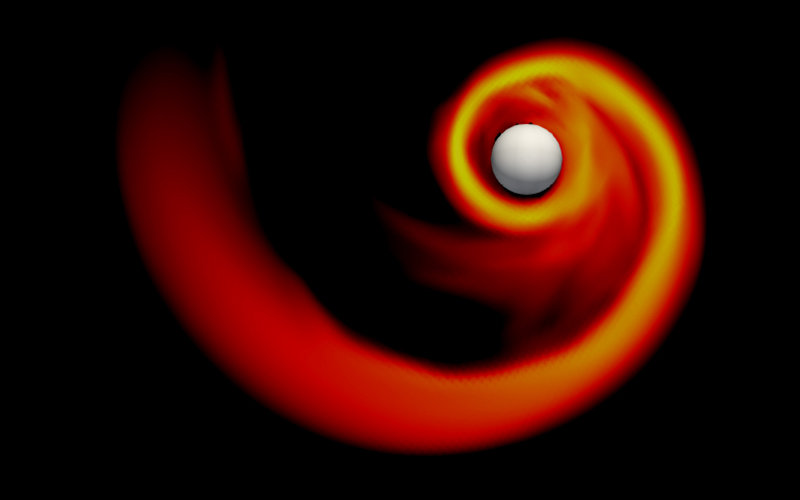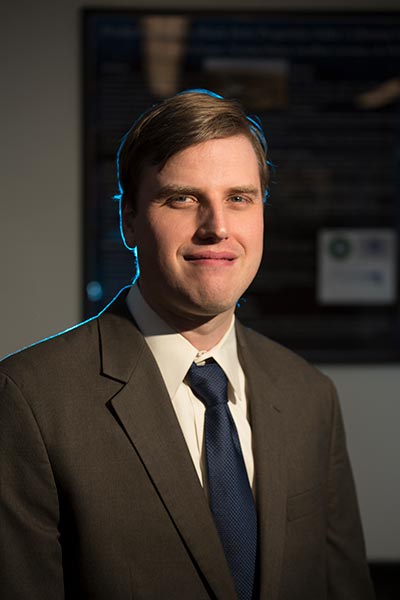
In what may be the first-of-its-kind detection of a neutron star-black hole cosmic collision, Cal State Fullerton gravitational-wave scientists and their students are working with LIGO and European Virgo collaborators to validate the unprecedented phenomena.
The Advanced Laser Interferometer Gravitational-Wave Observatory (LIGO) detectors in the U.S. and the Virgo observatory in Italy detected gravitational waves from the merger — possibly a neutron star devoured by a massive black hole — on Aug. 14, named candidate S190814bv.
If confirmed by scientists in the months to come, it would open a new window on how the universe works — and would be the third distinct kind of cosmic collision to produce measurable gravitational waves, or ripples in the fabric of spacetime predicted more than a century ago by Albert Einstein, said Joshua Smith, professor of physics and Dan Black Director of Gravitational-Wave Physics and Astronomy.
As members of the LIGO Scientific Collaboration, Smith, along with astrophysicist Jocelyn Read, associate professor of physics; Geoffrey Lovelace, associate professor of physics, who uses supercomputers to model sources of gravitational waves; and their students in the Gravitational-Wave Physics and Astronomy Center contributed to several gravitational-waves discoveries produced from merging black holes and the collision of neutron stars. Since the first discovery in 2015, a total of 10 binary black hole mergers and one binary neutron star merger have been confirmed to date, with other potential candidates being analyzed, Smith noted.
With the latest possible detection of a never-seen-before neutron star-black hole merger, the researchers are combining their team’s expertise, with those of their LIGO and Virgo collaborators, to understand this new type of astronomical event.

Is this something you’ve been hoping to detect?
Lovelace: My jaw dropped when I saw the data! It was such a beautiful, loud gravitational wave. But more than that, it also looked unusual, like the waves didn’t come from the same kind of source as the merging black holes and merging neutron stars we’ve seen so far.

What do black holes and neutron stars have in common?
Read: Out of everything in the universe we know about, black holes and neutron stars pack the greatest amount of mass into the smallest region of space. This makes for the strongest gravitational effects and stirs up gravitational waves that LIGO and Virgo can measure.
What is the significance — if confirmed?
Lovelace: This type of merger is influenced by both the exotic nuclear physics of neutron stars and the extremely strong gravity near the black hole’s horizon. We don’t yet know how many pairs of black holes and neutron stars are out there in the universe, and we don’t know what kinds of black holes and neutron stars they contain or how they form. To find out, we need observations of gravitational waves from merging black holes and neutron stars. This observation, if confirmed, will give us our first example of this kind of exotic binary.

What’s next to confirm this kind of merger?
Smith: This is a quite confident gravitational-wave detection. Dr. Lovelace and Dr. Read and their students will work toward improving our understanding of the source by comparing the gravitational waves detected with model and computer simulated waveforms. My role will be primarily in helping to validate new discoveries as they appear as part of LIGO’s Rapid Response Team.
What is likely to have happened in the universe to create this phenomenon?
Read: One of the exciting things about this kind of gravitational wave signal is that we’re not sure how a neutron star-black hole merger would be produced. This could be the first one ever measured! It would tell a new story about how such systems come to be — maybe they are born together in a binary star system where each star exploded and collapsed to a different fate. Or perhaps the neutron star and black hole first encountered each other later in their histories, in the complicated gravitational dance of a whole population of heavy objects at the center of a star cluster. LIGO and Virgo data should hold lots of clues about the system that produced this gravitational wave, but it takes a lot of work to dig in and disentangle the details.
What could this phenomena tell us that the other mergers have not?
Read: There’s a lot of uncertainty about extremely dense matter and just how massive neutron stars can be. We know they can get up to two times the mass of the sun, but we’re not sure how much beyond that. If the smaller of the pair was more than three times the mass of the sun, it has to have collapsed to a black hole. Instead, the classification puts it at less than three times the sun’s mass, so it’s possible that it’s a neutron star. Observing such systems will teach us about how stuff behaves at extremes of density and pressure that we can’t recreate here on Earth.
Lovelace: If it turns out this is a neutron star merging with a black hole, we’ll either increase how confident we are in our understanding of how neutron star matter and strongly curved spacetime behaves — or something in the measurements will surprise us.